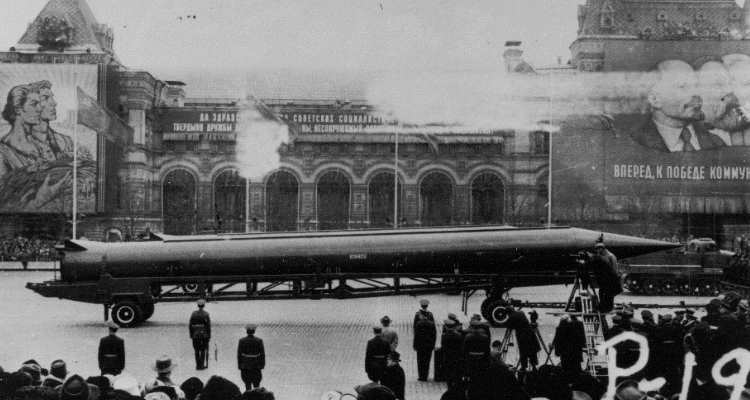This series on Great Movies for Teaching U.S. History, from the Revolutionary War to the Cold War, will publish on consecutive weekdays through May 2. It features films and documentaries inspired by historical events in the United States, including information about their educational value, ratings and appropriateness for children, and how well they represent the time periods covered.
The Cold War 1947-1991
The Cold War began at the end of World War II, after the Allied Powers defeated the Axis of Evil, and both America and the Soviet Union found themselves in places of power. The Soviet Union believed in spreading communism, while the capitalist West worked to prevent that. For more than 40 years East and West would be at a standoff, each aiming a nuclear gun to the world. The Cold War spanned several decades, but tensions grew in the late 20th century, and what would have been the beginning of World War III was avoided. The East and West competed for strength in many ways, including through military and the production of nuclear weapons. The first films featured in this article delve into the major events of the war including, the Space Race, as well as tensions with Cuba and Vietnam.
The Cold War was named as such because it included conflicts in Vietnam and Afghanistan, but the United States and Soviet Union never had any large scale battles against one another. It was more a flexing of muscles and using psychological warfare to belittle or demean the opposing side. For instance, one movie, The Grapes of Wrath (featured in our post about Great Depression era movies, was at first allowed to be shown in the Soviet Union because it represented the United States in poor condition. It was later censored because it showed poor citizens could own automobiles. The second group of films featured in this article examine some of these major showdowns, which brought the U.S. to the brink of a Nuclear War.
The Vietnam War is one of the most controversial wars of American History. Much of the war was aimed at ending the spread of Communism, and the films about this time in history that are featured in this article show two very different perspectives of the war. They are aimed towards a more mature audience and both contain very mature themes.
October Sky: 1957
The movie is based on the book Rocket Boys and is an anagram of the title. This film follows one young man, Homer, and his obsession with space and sending a rocket to space. The Soviets were able to launch Sputnik, the first satellite into space, which inspires the young Homer to build and test rockets. The film follows Homer and his friends as they design, test, and try and perfect rockets.
The film serves as a great period piece, as well as a fantastic film to get any young learner interested in space or rockets. It’s based on the life of Homer Hickam, who serves as an inspiring role model. Several scenes include family disputes with some mild violence.
[embedvideo id=”gnX6yU8PJHE” website=”youtube”]
The Right Stuff: 1947-1963
This film, based on the book of the same name, also focuses on the Space Race. Sputnik was the first man-made object sent into orbit by the Soviet Union. This began the Space Race, when the United States and the Soviet Union competed to become the first to put a man in space. This film follows the seven men who volunteered for the first manned space flight. The candidates were from the U.S. Marine Corp, the U.S. Navy and the U.S. Air Force. The National Film Preservation Board states, “The Right Stuff is a tribute to the space program’s role in generating national pride and an indictment of media-fed hero worship.”
The film also touches on the personal lives of the potential astronauts; the frustrations and fears they had, as well as what their family had to endure in the process, causing intense interactions.
[embedvideo id=”Ak1n6qQS3_A” website=”youtube”]
Thirteen Days: 1961
- Rating:PG-13
- Available on Netflix
- Nominated for two Political Film Society Awards and won one
The film is a retelling of the events that led up to the Cuban Missile Crisis, after the failed Bay of Pigs mission. The film is based on the book, The Kennedy Tapes: Inside the White House during the Cuban Missile Crisis. While JFK was obviously a huge factor as the acting president during the time the film’s protagonist is actually Kenneth O’Donnel, the president’s advisor.
The film shows the stress the president endured during this time. He tries to represent a strong American government without triggering World War III. Some suggest that the president personified many of the emotions the American people as a whole were feeling during that time.
The JFK Library has many resources for individuals who are interested in learning more about this time period. The film strives to offer an accurate portrayal of the events surrounding the 13 days. The film has several swear words throughout.
[embedvideo id=”M19tgYuwVWc” website=”youtube”]
Dr Strangelove: 1964
- Rating: PG
- Available on Netflix
- Nominated for four Oscars
A satirical look at the crisis with the Soviet Union from director Stanley Kubrick. He intended to make a series film that examined the core of the Cold War. However, as the film matured, the idea of mutually assured destruction was deemed so ludicrous that the filmed worked better as a comedy.
The film examines the fear and irrationality that sometimes gripped American citizens. A general firing a nuclear missile at the Soviet Union, miscommunication, and politicians gambling (the set designer created the war room to resemble a gigantic poker table) and rationalizing American lives, allowed people to laugh at was going on. The film captures the essence of the Cold War so well that it was preserved by the National Film Preservation Board in 1989.
The film is filled with dark humor, and there is mild violence. The film is rated PG but may not appeal to a younger audience, because of the mature themes and satire.
[embedvideo id=”TsyXEDznAMs” website=”youtube”]
Good Morning Vietnam: 1965
- Rating: R
- Available on Netflix
- The film was nominated for several awards
While the film’s setting is Vietnam, this film does not focus on the battles or the fighting of the war. The protagonist is a radio DJ who is well liked by the soldiers and brings an upbeat attitude to the otherwise frightening ordeal. The film is based on Adrian Cronauer, a real sergeant in the U.S. Air Force. Cronauer admits that the film is exaggerated, but also suggests that the characters can personify real people. It’s true that he taught English, and the ‘Gooooooooooood Morning Vietnam!’ he began with continued after he left.
The film may follow one DJ, but the experiences he faced happened to real life soldiers, dealing with superior officers, Viet Cong attacks, and how the soldiers incorporated themselves into the local lifestyle. Each broadcast, he jokes about the current events of the time and relates to the struggles that many soldiers faced.
The film includes a handful of action sequences, and some of the images portrayed can be too much for a younger audience, as well as several curse words throughout the film. The edited for TV version is more appropriate for kids.
[embedvideo id=”3mJoHqmtFcQ” website=”youtube”]
Born on the 4th of July: 1967-1976
- Rating: R
- Available on Netflix
- Nominated for eight Oscars and won two
A much darker look at what soldiers faced during the Vietnam War, and when returning home. The film is based on the autobiography of the same name and is about the life of Ron Kovic. The film portrays a young man who is committed to going to Vietnam to fight for his country. While some are drafted to go to war, he willingly enlists. He is injured and finds out firsthand what it is like to be in a Veteran’s hospital, and does not receive the warm welcome he expects when he comes home.
The movie follows his efforts in anti-war demonstrations, as well as his fight for better treatment for Veterans returning home. While the film is centered around one man and his struggles, it personifies the conditions that many men faced upon returning home from Vietnam, especially when the anti-war movement was reaching a climax in the 1970s. The film portrays the anti-war movement very well. The author of the book co-wrote the screenplay.
The film is geared towards a more mature audience and features soldiers fighting in battle, graphic injuries, as well as more explicit scenes and language.
[embedvideo id=”t8NR6n1nRMI” website=”youtube”]
Cold War Documentary: 1917-1991
- Rating: NR
- Available on Netflix
- Nominated for several awards and won a Peabody
Serving as somewhat of a recap to all the films featured above, this series produced by CNN is a 24-part series that examines all the parts leading up to and following the Cold War. The film begins with the Russian Revolution in 1917 and documents major events such as Stalin’s rise to power, World War II, the Berlin Wall, the conflicts in Afghanistan and Vietnam, and many more. The film uses historic footage, as well as interviews from prominent figures with firsthand experience during that time. Everyone from Foreign Service officers to the former Soviet Premier, Sergei Nikitich Khrushchev and Fidel Castro are interviewed to give the film an authentic voice.
[embedvideo id=”YaH7Xe2fRBs” website=”youtube”]









































































































